Ford’s 1.0-liter Fiesta tops L.A. Auto Show debuts
By John Gilbert
LOS ANGELES, CALIF. — The Los Angeles Auto Show has become the vanguard of the “Big Four” auto extravaganzas in the U.S. By running from late November into early December, it has climbed to the pinnacle of anticipation for the domestic auto show season, which resumes with shows in Detroit in January, Chicago in February, and New York in April.
The 2012 Los Angeles show completed its run on Sunday, December 9 at the Los Angeles Convention Center, and amid an array of new high-mileage, low-emission, futuristic concepts, and useful family vehicles, it was Ford that jumped into the forefront, starting with a press introduction of its newly equipped Ford Fiesta, which will be coming out in several new forms, including one with a unique three-cylinder, 1.0-liter engine. We haven’t yet digested all of the 2013s, and Ford led off with some breakthrough technology for a 2014 model.
Domestic auto-makers, who used to reserve their biggest introductions for the Detroit show, were prominent in L.A. again, led by Ford’s tempting look at the European-issue Fiesta which will follow with U.S. distribution by the end of 2013. The high-tech 1.0-liter not only has only three cylinders, but it is one of Ford’s new “EcoBoost” family of smaller-displacement engines that improve fuel economy while also using turbocharging to deliver the power of a bigger engine. The 1.0-EcoBoost supplies, plenty of pep, even while driving through the mountainside highways above Santa Monica. The Fiesta’s subcompact body also is coming out in ST form, which will have a more potent 1.6-liter EcoBoost engine, prepared by the company’s SVT (Special Vehicle Team) high performance arm, assuring that high mileage also can include a kick.
Some of the highlights on the floors of the LA Convention Center, were unveiled at the two press days that preceded the show’s 10-day run. Hyundai once again upstaged its competitors with a party into the night after the first press preview day, at the Figueroa Hotel, complete with mermaids in the pool, and Jack Black performing some Tenacious D music inside.
Chrysler, which is now owned by Fiat, unveiled the new Dodge Viper V10 sports car, but left the biggest splash to Fiat, which not only brought out three new models of the feisty little 500 — a lengthened 4-door “L” model, a smaller pure-electric model with 80-100-mile range, and a rollback convertible top for the turbocharged Abarth model — but also offered a flurry of new and provocative television ads.
Fiat was the star of the last Super Bowl ad campaigns with its Fiat Abarth commercial, and the same show-stopping model not only was present and available for countless photos at the press introduction, but stars, with the cars, in several new commercials. Watch for one co-starring a scorpion, which is the symbol of the sporty Abarth, and has an apparent quest to attain bikini tops, and another clever one where a young man picks up his girlfriend and her parents in the new L 4-door, for a ride that includes a few tunnel-passing surprises. All of them should be appearing on TV soon, but in the meantime they attracted attention from all the neighboring booths at the L.A. show as they continued on the Fiat big screen.
Some new vehicles from Korean partners Hyundai and Kia were prefaced by apologetic comments from their executives for computing errors that the companies will compensate for, after leading to EPA gas mileage estimates that may have been high by a mile-per-gallon or two. Hyundai displayed the short and long versions of its new Santa Fe, which replaces both the existing Santa Fe and the longer Veracruz, and Kia showed an updated Sorento SUV, and a restyled Forte compact sedan.
An interesting reaction to ideas that might not have been good the first time around came from Toyota and Honda.
Toyota lengthened the RAV-4, popular compact SUV, by over a foot and added a third row seat and a V6 engine at its last major renovation. It has remained popular, but the rival Honda CR-V took over and became the most popular SUV on the market. Now, almost eight years later, Toyota has decided to shorten the RAV-4 a bit, and to do away with the V6 option to stick with 4-cylinders. Welcome back.
Honda came out with an all-new Civic for 2012, but it was sharply criticized for its low-rent interior, which was aimed at keeping the price down but came at a time when several prominent compact competitors had refined their interiors upscale. Honda executives have apologized for the mistake and said they would fix it. Art StCyr took the podium and made it sound as though the change was an indication of Honda’s quick-reacting engineering, but the hyperbole didn’t work. StCyr said the new Civic, which has a new look grille, similar to the Insight Hybrid, and softer, more luxurious features plus back-up cameras and other amenities for only $160 more than the short-lived 2012, was in the design stages even as its predecessor was brought out.
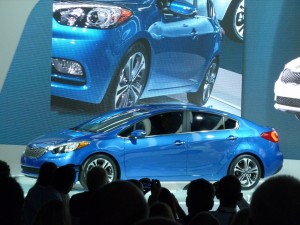
The all-new 2012 Honda Civic is supplanted by a new-look 2013 model with new grille, interior amenities.
“We didn’t have time to get all the features installed,” he said.
“Why not wait another year, then?” he was asked, while it was pointed out that designers always start on the next generation as soon as one is introduced.
“Did the 2012 model have to happen in order to force the new 2013?” StCyr was asked.
“I don’t know what you mean by that,” he said.
“Well, has Honda ever before brought out an all-new model, knowing it was going to replace it in a year?”
“No,” StCyr answered.
I told StCyr later that I wasn’t trying to be chippy, but those were questions that needed answering. He thanked me and said they were valid questions and he was surprised nobody else asked them. His best point was that those who bought 2012 models didn’t buy bad cars; the new one is just improved.
Mazda unveiled its new Mazda6 midsize sedan, with a 2.5-liter Skyactiv 4-cylinder, reiterating that all its new engines will have Skyactiv technology, which is a thorough renovation of the interior of the engine, including the block, with longer stroke, smaller bore, and special intake and exhaust systems, plus new transmissions, in order to extract significantly higher fuel economy. The Mazda3 started with a 2.0 Skyactiv, and the new-for-2013 CX-5 compact SUV houses the full manifold system and will outperform the sporty Mazda3 on a race track, while getting mid-30s mpg. A redesigned CX-9 full-size SUV also now wears the signature blunt nose of the CX-5 and Mazda6. Mazda officials reiterated their intention to bring in a new 2.2-liter turbo-diesel for the new sedan and SUV entries.
Volkswagen offered a new cabrio (convertible) model of its Beetle compact, and showed off the impressive new Jetta Turbo Hybrid, the industry’s first attempt at combining a small (1.4-liter) engine with turbocharging and hybrid technology.
Acura unveiled its RLX, which is the name the brand’s luxury leader will now use, replacing RL. It has all-wheel drive available, and the latest all-wheel steering, called “P-AWS.” Naturally, the language exchange will have fun with the chrome “Paws” sign on the rear. Better than “Pause,” probably. A new three-motor hybrid is coming soon. Acura also displayed a beautiful new concept roadster, and displayed the near-finished version of its new NSX sports car.
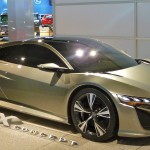
Acura's high-tech NSX is nearly ready for production, while the brand's upscale halo car (right) will be the RLX, replacing the RL.
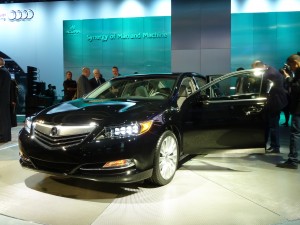 A new Land Rover model, and a pair of spectacular looking new Jaguars shared a stand, as the two British makes now are owned by Tata Motors of India. Porsche brought out a new and longer Cayman sports coupe.
A new Land Rover model, and a pair of spectacular looking new Jaguars shared a stand, as the two British makes now are owned by Tata Motors of India. Porsche brought out a new and longer Cayman sports coupe.
Audi’s U.S. president Scott Keogh spoke about his company’s commitment to turbo-diesels and said its A3 and Q7 TDIs had done so well, the company will also bring in TDI models of the A6, A7, and A8 sedans, and the midsize Q5 SUV. He said the company vowed to prove the TDI engines get 30 percent better fuel economy, lower particulate and evaporative emissions, and lower nitrous oxides, and that in the last year, 33 percent of the Q7 SUVs were sold with TDI engines, and a whopping 55 percent of A3 compacts went out of showrooms with TDI power. “It allowed the U.S. to save $26 million in gasoline costs, and sacrificed nothing,” Keogh said, calling the TDIs with their fantastic torque thrust “cars without compromise.”
BMW also had a flashy new rear-engine concept sports car that was a major attraction. The German company continues to produce vehicles that are the standard of the industry, including the current 3-Series that is a Car of the Year finalist, and the new X1 compact SUV that is a Truck of the Year finalist.
Chevrolet, which has its new subcompact Ronic and smaller Spark on the market, showed its new Impala and Malibu sedans, which look quite similar, although the Impala is larger. But Chevy held off displaying the new Corvette, which reportedly is being held in reserve for Detroit.
Comments
Tell me what you're thinking...
and oh, if you want a pic to show with your comment, go get a gravatar!


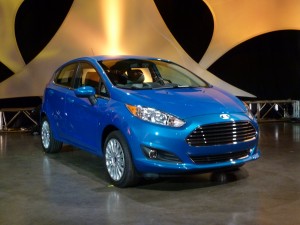
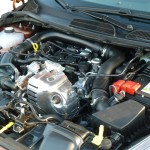
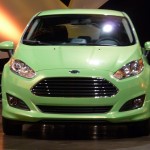
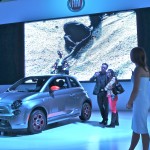
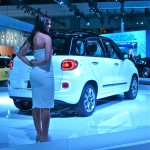
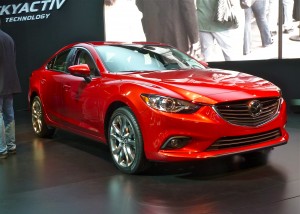
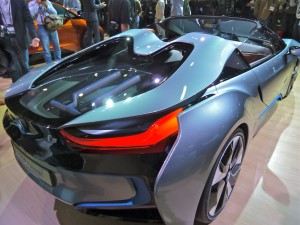
 John Gilbert is a lifetime Minnesotan and career journalist, specializing in cars and sports during and since spending 30 years at the Minneapolis Tribune, now the Star Tribune. More recently, he has continued translating the high-tech world of autos and sharing his passionate insights as a freelance writer/photographer/broadcaster. A member of the prestigious North American Car and Truck of the Year jury since 1993. John can be heard Monday-Friday from 9-11am on 610 KDAL(www.kdal610.com) on the "John Gilbert Show," and writes a column in the Duluth Reader.
John Gilbert is a lifetime Minnesotan and career journalist, specializing in cars and sports during and since spending 30 years at the Minneapolis Tribune, now the Star Tribune. More recently, he has continued translating the high-tech world of autos and sharing his passionate insights as a freelance writer/photographer/broadcaster. A member of the prestigious North American Car and Truck of the Year jury since 1993. John can be heard Monday-Friday from 9-11am on 610 KDAL(www.kdal610.com) on the "John Gilbert Show," and writes a column in the Duluth Reader.